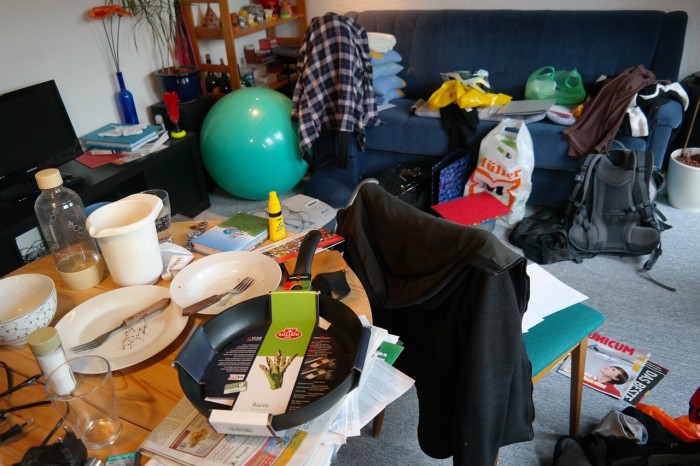
The unexpected sound of the doorbell used to shoot panic through me. Sometimes it still does.
Not because I don’t like pop-ins, or because it might be an evangelist, although those are good reasons too.
It’s because I don’t want people to see how I actually live.
Since I was a child, I’ve surrounded myself with clutter. When my grades starting plummeting in middle school, it wasn’t because I didn’t do my homework. It was because I couldn’t find my completed work amidst my fat folders, they were so jammed with papers.
In high school, my large bedroom was so sprawled with clothes, CDs, and half-written on slips of paper that I could barely see the floor. My parents begged me to clean my room, but I insisted that I liked it that way, and could find everything I needed, and could everyone please leave me alone so I can read Anais Nin and masturbate in my dirty den of chaos.
I am fairly sure that shortly after I was born, my mom delivered a small pile of crumpled receipts and loose, filthy change along with the blood-bruised placenta.
And ever since then, I’ve been secretly fighting a battle against clutter.
When I insisted that I liked my room messy as a teen, I didn’t actually like it. I was overwhelmed by it. I’ve always had an irrational, overly sentimental streak that attaches meaning to items that I don’t use or need—but that peach-hued shirt that turns my skin sallow was from my dead grandma so I can’t possibly throw it out! Combined with my inability to organize, I simply didn’t know how to live any differently.
The momentum of life hasn’t helped my struggle with clutter. Though I’ve learned to let things go, my two kids constantly trail in a never-ending supply of papers, plastic toys, and sometimes, sharp sticks.
I’m not alone in feeling crushed by clutter. According to a study by the National Association for Professional Organizers, 54 percent of Americans feel overwhelmed by their clutter, and 78 percent have no idea what to do with their excess stuff. Given the booming popularity of Marie Kondo’s bestselling de-cluttering book, The Life Changing Magic of Tidying Up, and reality shows like Hoarders, this shouldn’t be surprising. And yet many of us who struggle with clutter feel like we’re the only ones living with this untidy secret.
The Pinterest-perfect images of what I think my home should look like brutally contrast with the reality of my home. In an era where social media often shows us the prettiest parts of other peoples’ lives, it sometimes feels like everyone else has their shit together but me.
Clutter used to serve me.
My mess kept me distracted. Clutter kept me from writing, because looking around at a clutter-strewn room sucked out all my energy. Clutter was as an excuse to avoid going out and being in the world, as I told myself I needed instead to stay home and clean. And I used it as a barrier against having people over—I was mortified that people would see how I lived. I was stuck in an endless loop of literally making a mess out of my life and then using that mess to keep myself from thriving.
As they say in recovery programs, I used clutter to try and fill the God-shaped hole in me.
It didn’t work.
Clutter doesn’t serve me anymore. My energy sinks every time I look around and my eyes are unable to rest as they skim from toy to paper pile to the crumbs under the dining room table.
Fortunately, there are solutions. From inspiring blogs on minimalism to 12-step programs for those who struggle with clutter, there is help. It doesn’t happen overnight—and for many of us, it’s a slow, nonlinear process of retraining ourselves around our relationship to objects. It’s about trudging through daily routines while being mindful of our long-term goals. It’s about trusting the universe to provide us with what we need instead of hoarding items “just in case.”
It’s about someday hearing the doorbell ring and walking toward it with curiosity instead of panic.
Author: Lynn Shattuck
Editor: Catherine Monkman
Photo: Pixabay











Read 0 comments and reply